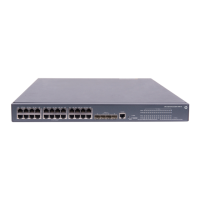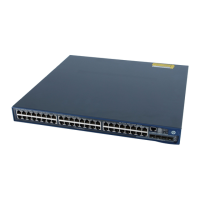120
• An increase in multicast adds a great burden to the RP, increasing the risk of failure.
To solve these issues, PIM-SM allows an RP or the DR at the receiver side to initiate an SPT switchover
process when the traffic rate exceeds the threshold.
1. The RP initiates an SPT switchover process
The RP can periodically check the passing-by IPv4 multicast packets. If it finds that the traffic rate
exceeds a configurable threshold, the RP sends an (S, G) join message hop by hop toward the multicast
source to establish an SPT between the DR at the source side and the RP. Subsequent multicast data
travels along the established SPT to the RP.
NOTE:
For more information about the SPT switchover initiated by the RP, see “Multicast source registration.”
2. The receiver-side DR initiates an SPT switchover process
After receiving the first multicast packet, the receiver-side DR initiates an SPT switchover process:
• The receiver-side DR sends an (S, G) join message hop by hop toward the multicast source. When
the join message reaches the source-side DR, all the routers on the path created the (S, G) entry in
their forwarding table, and an SPT branch is established.
• When the multicast packets travel to the router where the RPT and the SPT deviate, the router drops
the multicast packets received from the RPT and sends an RP-bit prune message hop by hop to the
RP. Upon receiving this prune message, the RP sends a prune message toward the multicast
source—suppose only one receiver exists—to implement the SPT switchover.
• Multicast data is directly sent from the source to the receivers along the SPT.
PIM-SM builds SPTs through SPT switchover more economically than PIM-DM does through the flood-and-
prune mechanism.
Assert
PIM-SM uses an assert mechanism that is similar to what PIM-DM uses. For more information, see
“Assert.”
BIDIR-PIM overview
In some many-to-many applications, such as multi-side video conference, there might be multiple
receivers interested in multiple multicast sources simultaneously. With PIM-DM or PIM-SM, each router
along the SPT must create an (S, G) entry for each multicast source, consuming a lot of system resources.
BIDIR-PIM is introduced to address this problem. Derived from PIM-SM, BIDIR-PIM builds and maintains
bidirectional RPTs, each of which is rooted at an RP and connects multiple multicast sources with multiple
receivers. Traffic from the multicast sources is forwarded through the RP to the receivers along the
bidirectional RPT. In this case, each router needs to maintain only a (*, G) multicast routing entry, saving
system resources.
BIDIR-PIM is suitable for networks with dense multicast sources and dense receivers.
The working mechanism of BIDIR-PIM is summarized as follows:
• Neighbor discovery
• RP discovery
• DF election
• Bidirectional RPT building

